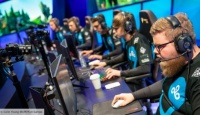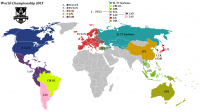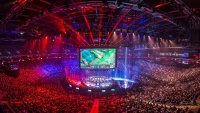Professional League of Legends
Professional League of Legends is the organized playing of League of Legends. Players are employed by various organizations that often have teams for several eSports. Given its global popularity, there are professional teams in most parts of the world. Asia, particularly South Korea and China, have the most competitive environments and the largest consumer base. Teams compete within their respective region and top performers are selected to compete at international competitions. League of Legends and eSports as a whole has been growing quickly in popularity. Playing professionally is now a full-time job that offers competitive salaries.
Contents
History
The possibility of video games as a career was not always present. Although League of Legends has organized a Worlds event since Season 1 of the game, the landscape was completely different. There were not teams employing salaried players, many were making just enough to get by. Many teams were simply groups of friends. For many, the primary source of income was prize winnings from various tournaments. As gaming organizations became more fleshed out, gaming as a career became more of a possibility.
Early attempts at organizing professional League of Legends included a promotion and relegation system. Many fans preferred the relegation system as it made even the lower level matches exciting, but it was not feasible to have so much volatility for gaming organizations. The leagues eventually moved to a franchise system. The North American League Championship series allowed 10 spots with a buy-in of $10 million. They instituted a method to share profits amongst the gaming organizations while also adding several rules that the organizations had to abide by. Organizations were required to provide players with financial and career planners. The minimum salary was also increased from $25,000 to $75,000. Although $75,000 is the minimum, several players have contracts for much more. Organizations are paying out millions of dollars to attract both talent and players with good name recognition. All organizations were also required to have an 'Academy' team to focus on development of new talent.
The talent development pipeline has also developed throughout the years. eSports organizations now have 3 major sources for their talent; their Academy team, Amateur teams, and Collegiate teams. The Academy team is associated with the franchised team and often has players moving between the academy roster and main roster. Amateur teams are typically attached to other eSports organizations that do not have a franchised spot in a regional league. Collegiate teams are present at many universities and colleges. The CLOL is the collegiate league for teams. ESPN now broadcasts a variety of CLOL games and hosts an eSports section on their website. Many colleges and universities are building out their eSports divisions and even offering scholarships to players.
https://www.lineups.com/esports/top-25-esports-scholarships/#4-Ohio-State-University
https://lol.fandom.com/wiki/College_League_of_Legends
As different regions evolved, organizations began importing players between regions. This allowed for fresh perspective and an increased talent pool. South Korea had emerged as the dominant region in international competitions during the mid 2010s, so many South Korean players were imported to play for North American and Chinese teams. Back in 2013, Riot Games also was able to convince the US Citizen and Immigration Services to grant athletic visas to professional League of Legends players (known as P-1 or individual athlete visas). This made it even easier for teams to attract foreign talent, but created some long term problems. Many "North American" teams came to be dominated by European and South Korean players, leaving many fans disillusioned. The solution was more rules that capped the number of import slots that each gaming organization had, guaranteeing that a majority of players on each team had residency in the region they played in. Importantly, players on a P-1 visa are considered to have residency after 4-5 years of playing in the United States. This means that teams are able to import more players after previous imports gain residency. Many gaming organizations want to see the import rules lifted, while most viewers support the cap on slots.
https://liquipedia.net/leagueoflegends/NA_LCS_Franchising
Popularity
League of Legends has seen surges in popularity both in player base and professional match viewer base. In 2011, League of legends had between 10 and 15 million monthly players. By 2014, this number had reached more than 50 million and by 2017 the game had over 100 million active monthly players. The numbers for people playing the game and watching the game are strongly correlated.
The eSports industry has grown considerably each year. China has the largest share of player base and has the largest eSports industry, but they are very strict with their data releases so it is tough to get an idea of the true size of eSports in China. China also recently implemented a law limiting the amount of video games to just 3 hours a week for people under 18. This is expected to slow the growth of all video games, League of Legends included. The South Korean eSports industry was estimated to be worth only 5 trillion won in the early 2000s, but it has quadrupled to over 20 trillion won in the early 2020s. This is due to an increased number of viewers which means an increased number of sponsors. The Korean league has attracted massive sponsors like Woori Bank, SecretLab, Logitech, HP Omen, KLEVV, McDonalds, Kia, and SK Telecom. Although sponsors are being removed from team names, many teams used to include their sponsorship in their name (Damwon Kia and SKT T1).
https://lol.fandom.com/wiki/LCK/2021_Season/Spring_Season
The North American industry has seen the greatest recent growth, both in overall industry size, and sponsorships. The viewer base has increased by over 10 million viewers in the past 5 years to over 30 million viewers. The North American League now has sponsorships from Honda, MasterCard, RedBull, Bud Light, FTX, Samsung, State Farm, Verizon, Secret Lab, GrubHub, Buffalo Wild Wings, Green Park, Roccat and more. The increase in viewer base and sponsorship has gotten the attention of venture capitalists. Millions of dollars are being invested in teams and organizations as eSports is becoming increasingly important to culture. The overall eSports industry in North America surpassed a valuation of $1 billion for the first time in 2021 and is expected to approach $2 billion in 2022. The Coronavirus pandemic further spurred growth both in 2020 and 2021 and many competitions were held remotely.
https://www.reuters.com/world/asia-pacific/esports-talent-skorea-gets-boost-big-business-easing-gaming-ban-2021-10-28/ https://www.statista.com/statistics/825058/south-korea-gaming-industry-size/ https://www.insiderintelligence.com/insights/esports-ecosystem-market-report/
Broadcasting
Riot Games, the creator of League of Legends, employs a broadcast team to host professional matches and create other related content. Many hosts are early employees of Riot or former League of Legends professionals. The content has long been broadcasted through online mediums such as Twitch, Youtube and YouTube gaming, and Trovo. Some television networks like ESPN are experimenting with League of Legends. Riot Games has struggled recently in balancing the broadcasting rights of their games. Popular content creators outside of the official broadcast team have become increasingly popular in recent years. Members of the League of Legends community like Sneaky, Meteos, Doublelift, LS, and IWillDominate have popularized 'CoStreaming' of professional League of Legends games. In 'CoStreaming', these creators stream themselves watching, which effectively reduces viewership of the main stream. Riot Games has been changing their rules to defend their advertisement revenue. For larger tournaments, they have completely banned CoStreaming and for the 2022 seasons, only select games will be available for content creators to CoStream. Many creators have made their own systems and websites to instead conduct "Live Viewings" of games. Viewers and creators both watch the main stream, but viewers sync their viewing time with creators.
Riot Games also hosts live events throughout different regions. The players are typically placed in the center or front of a venue/stadium with the game broadcasted onto various screens and Jumbotrons. stadiums
Regional Leagues
LCS, LEC, LPL, LCK are the current major regions. These major regions are given multiple spots at the World Championship, while only the top team from minor regions is given a spot.
Notable Teams
Several organizations have emerged in popularity and notoriety in each region. They are often revered for their history or their performance.
Edward Gaming
Invictus Gaming
FunPlus Phoenix
Damwon Gaming
T1
T1, formerly known as SKT T1 is widely known as the most successful League of Legends team of all time. Faker, who has only played for T1 is widely accepted as the best League of Legends player of all time.
Fnatic
G2
Taipei Assassins
Samsung Galaxy
Team SoloMid
Counter Logic Gaming
Cloud 9
International Competitions
Worlds
The League of Legends World Championship (Worlds) is an annual tournament played at the end of each season. The competition is separated into a group stage and a knockout stage. Teams must play against other regions.
Mid Season Invitational
The Mid Season Invitational is an international League of Legends tournament played in the middle of the regular season. It is similar to worlds in that teams in each region compete for a spot at the Mid Season Invitational.
Life after Professional League of Legends
The career of a League of Legends professional is finite. Players are often very young as the game requires excellent hand eye coordination, reflexes, and critical thinking. This means that many players have short-lived careers and must pivot after being released from teams. Many players either go into coaching, broadcasting, or streaming while some return to school. Some are able to take their name recognition from playing professionally and successfully convert it into a streaming career in which they end up earning more money.


